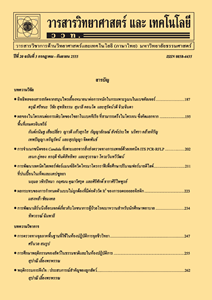การเจริญเติบโตของต้นเจตมูลเพลิงแดง (Plumbago indica L.) หลังออกปลูกเมื่อขยายพันธุ์ด้วยการเพาะเลี้ยงเนื้อเยื่อ
Main Article Content
Abstract
บทคัดย่อ
เจตมูลเพลิงแดง (Plumbago indica L.) เป็นพืชสมุนไพรที่มีการสะสมสาร plumbagin มากในส่วนของราก มีรายงานการเพิ่มจำนวนต้นเจตมูลเพลิงแดงในสภาพปลอดเชื้อแล้ว แต่ยังไม่มีการศึกษาการเจริญเติบโตของต้นที่ขยายพันธุ์ด้วยการเพาะเลี้ยงเนื้อเยื่อ และปริมาณสารสำคัญที่รากเมื่อออกปลูกในสภาพธรรมชาติ ดังนั้นการทดลองนี้จึงมีวัตถุประสงค์เพื่อศึกษาการเจริญเติบโตของต้นเจตมูลเพลิงแดงที่ได้จากการเพาะเลี้ยงเนื้อเยื่อ และปริมาณสาร plumbagin ในรากเจตมูลเพลิงแดงหลังการย้ายปลูกในสภาพธรรมชาติทุก ๆ 3 เดือน เป็นระยะเวลา 1 ปี ผลการทดลองพบว่าจำนวนกิ่งบริเวณโคนต้นและความกว้างทรงพุ่มมีค่าเพิ่มขึ้นอย่างมีนัยสำคัญตามอายุที่เพิ่มขึ้น หลังการย้ายปลูก น้ำหนักสดและแห้งของต้น และรากเพิ่มขึ้นอย่างต่อเนื่องตลอดการเพาะปลูก รากของต้นเจตมูลเพลิงแดงที่อายุ 3 และ 6 เดือนหลังการย้ายปลูก (months after planting, MAP) มีปริมาณสาร plumbagin ต่ำ เท่ากับ 10.69±5.08 และ 7.95±1.11 mg/g root DW ตามลำดับ เมื่อต้นอายุ 9 MAP มีปริมาณสาร plumbagin สูงสุด เท่ากับ 15.11±4.42 mg/g root DW แต่ไม่มีความแตกต่างกันทางสถิติกับปริมาณสารของต้นอายุ 12 MAP (13.11±4.76 mg/g root DW)
คำสำคัญ : เจตมูลเพลิงแดง; plumbagin; การเจริญเติบโต; การเพาะเลี้ยงเนื้อเยื่อพืช; ราก
Abstract
Plumbago indica L. is a medicinal plant that accumulates a large amount of plumbagin in its roots. It has been reported that this plant species can be propagated by plant tissue culture technique. However, there was no study on growth of in vitro grown plantlets and secondary metabolite accumulation in its roots after transplantation. Therefore, the objectives of this experiment were to examine plant growth after planting with in vitro plantlets and to determine root plumbagin contents at 3 month intervals for a year. The results showed that the number of branches and plant width significantly increased with the growing period. Fresh and dry weight of shoots and roots had been continuously enhanced throughout the experimental period. Roots at 3 and 6 months after planting (MAP) contained low plumbagin contents of 10.69±5.08 and 7.95±1.11 mg/root DW, respectively. The highest concentration of plumbagin (15.11±4.42 mg/g root DW) occurred at 9 MAP, however, there was no significant difference with that at 12 MAP (13.11±4.76 mg/g root DW).
Keywords: Plumbago indica L.; plumbagin; growth; plant tissue culture; root


